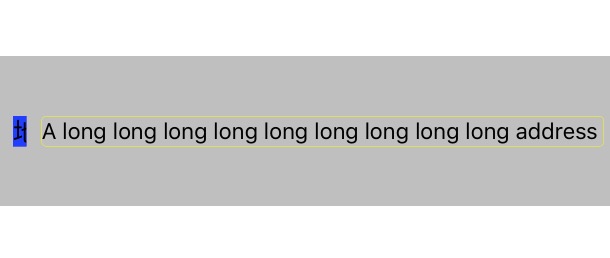自动布局与Masonry使用注意事项

1 理解自身内容尺寸约束与抗压抗拉
自身内容尺寸约束:一般来说,要确定一个视图的精确位置,至少需要4个布局约束(以确定水平位置x、垂直位置y、宽度w和高度h)。但是,某些用来展现内容的用户控件,例如文本控件UILabel、按钮UIButton、图片视图UIImageView等,它们具有自身内容尺寸(Intrinsic Content Size),此类用户控件会根据自身内容尺寸添加布局约束。也就是说,如果开发者没有显式给出其宽度或者高度约束,则其自动添加的自身内容约束将会起作用。因此看似“缺失”约束,实际上并非如此。
关于自身内容尺寸约束,简单来说就是某些用来展现内容的用户控件,它们会根据自身内容尺寸添加布局约束。
自身内容尺寸约束的抗挤压与抗拉抻效果。弹簧会有自身固有长度,当有外力作用时,弹簧会抵抗外力作用,尽量接近固有长度。
抗拉抻:当外力拉长弹簧时,弹簧长度大于固有长度,且产生向内收的力阻止外力拉抻,且尽量维持长度接近自身固有长度。
抗挤压:当外力挤压弹簧时,弹簧长度小于固有长度,且产生向外顶的力阻止外力挤压,且尽量维持长度接近自身固有长度。
关于抗压抗拉,就是布局冲突需要牺牲某些控件的某些宽度或者高度约束时,抗压高的控件越不容易被压缩,抗拉高的控件越不容易被拉升。即自身布局对抗外界布局的能力。
样例:
一种常见的业务场景是用户修改地址,在输入新地址之前先读取用户之前的地址作为填充。UI实现是水平平行的UILabel和UITextField。 代码实现如下:
- (NSString *)aLongAddress{
return @"A long long long long long long long long long address";}- (NSString *)aShortAddress{
return @"A short address";}- (void)sampleCode{
UIView *layoutView = [UIView new];
layoutView.frame = CGRectMake(0, 200, [UIScreen mainScreen].bounds.size.width, 100);
layoutView.backgroundColor = [[UIColor alloc] initWithRed:0.5 green:0.5 blue:0.5 alpha:0.5];
[self.view addSubview:layoutView];
UILabel *address = [[UILabel alloc] init];
[layoutView addSubview:address];
address.text = @"地址:";
address.backgroundColor = [UIColor blueColor];
[address mas_makeConstraints:^(MASConstraintMaker *make) {
make.centerY.equalTo(layoutView);
make.left.equalTo(layoutView).offset(10);
}];
UITextField *addressTextField = [[UITextField alloc] init];
[layoutView addSubview:addressTextField];
addressTextField.returnKeyType = UIReturnKeyDone;
addressTextField.font = [UIFont systemFontOfSize:15];
addressTextField.clearButtonMode = UITextFieldViewModeWhileEditing;
addressTextField.layer.borderWidth = 1 / [UIScreen mainScreen].scale;
addressTextField.layer.borderColor = [[[UIColor alloc] initWithRed:1 green:1 blue:0 alpha:1] CGColor];
addressTextField.layer.cornerRadius = 3;
addressTextField.text = [self aLongAddress];
[addressTextField mas_makeConstraints:^(MASConstraintMaker *make) {
make.height.equalTo(address);
make.centerY.equalTo(address);
make.right.equalTo(layoutView.mas_right).offset(-10);
make.left.equalTo(address.mas_right).offset(10);
}];}此处使用了UILabel的自身内容尺寸约束,当houseNumberTextField.text = [self aShortAddress]UI表现正常。
但,当houseNumberTextField.text = [self aLongAddress]时会出现address UILabel被挤压掉的情况,如下图所示:

原因是address Label的水平抗压缩没有设置。
在address Label创建的时候添加如下代码[address setContentCompressionResistancePriority:UILayoutPriorityRequired forAxis:UILayoutConstraintAxisHorizontal]则显示正常。
另,在某些情况下存在view被拉升,极有可能是没有设置抗拉升,此处不一一列举。
附,抗压抗拉相关API如下:
- (UILayoutPriority)contentHuggingPriorityForAxis:(UILayoutConstraintAxis)axis NS_AVAILABLE_IOS(6_0);- (void)setContentHuggingPriority:(UILayoutPriority)priority forAxis:(UILayoutConstraintAxis)axis NS_AVAILABLE_IOS(6_0);- (UILayoutPriority)contentCompressionResistancePriorityForAxis:(UILayoutConstraintAxis)axis NS_AVAILABLE_IOS(6_0);- (void)setContentCompressionResistancePriority:(UILayoutPriority)priority forAxis:(UILayoutConstraintAxis)axis NS_AVAILABLE_IOS(6_0);
2 NSLayoutConstraint只能修改constant
NSLayoutConstraint即自动布局的约束类,它是自动布局的关键之一。该类有如下属性我们需要重点关注。
NS_CLASS_AVAILABLE_IOS(6_0)
@interface NSLayoutConstraint : NSObject
// other code
@property UILayoutPriority priority;
@property BOOL shouldBeArchived;
/* accessors
firstItem.firstAttribute {==,=} secondItem.secondAttribute * multiplier + constant
*/
@property (readonly, assign) id firstItem;
@property (readonly) NSLayoutAttribute firstAttribute;
@property (readonly) NSLayoutRelation relation;
@property (nullable, readonly, assign) id secondItem;
@property (readonly) NSLayoutAttribute secondAttribute;
@property (readonly) CGFloat multiplier;
/* Unlike the other properties, the constant may be modified after constraint creation. Setting the constant on an existing constraint performs much better than removing the constraint and adding a new one that's just like the old but for having a new constant.
*/
@property CGFloat constant;
/* The receiver may be activated or deactivated by manipulating this property. Only active constraints affect the calculated layout. Attempting to activate a constraint whose items have no common ancestor will cause an exception to be thrown. Defaults to NO for newly created constraints. */
@property (getter=isActive) BOOL active NS_AVAILABLE(10_10, 8_0);
// other code
@end布局公式:firstItem.firstAttribute {==,<=,>=} secondItem.secondAttribute * multiplier + constant
解释:firstItem与secondItem分别是界面中受约束的视图与被参照的视图。
注意:当使用代码来修改约束时,只能修改约束的常量值constant。一旦创建了约束,其他只读属性都是无法修改的,特别要注意的是比例系数multiplier也是只读的。
Masonry是基于NSLayoutConstraint等类的封装,也正是如此,我们在调用- (NSArray *)mas_updateConstraints:(void(^)(MASConstraintMaker *))block的时候也只能更新NSLayoutConstraint中的@property CGFloat constant。
在MASViewConstraint找到如下代码可以佐证:
- (void)install {
// other code
MASLayoutConstraint *existingConstraint = nil;
if (self.updateExisting) { //如果是update,则去匹配对应的existingConstraint existingConstraint = [self layoutConstraintSimilarTo:layoutConstraint];
}
if (existingConstraint) { //找到了existingConstraint,最终也只更新了existingConstraint.constant // just update the constant existingConstraint.constant = layoutConstraint.constant;
self.layoutConstraint = existingConstraint;
} else { //没有找到existingConstraint,添加一个新的约束 [self.installedView addConstraint:layoutConstraint];
self.layoutConstraint = layoutConstraint;
[firstLayoutItem.mas_installedConstraints addObject:self];
}}// 除了constant,其它都一样的约束是Similar约束- (MASLayoutConstraint *)layoutConstraintSimilarTo:(MASLayoutConstraint *)layoutConstraint {
// check if any constraints are the same apart from the only mutable property constant
// go through constraints in reverse as we do not want to match auto-resizing or interface builder constraints // and they are likely to be added first. for (NSLayoutConstraint *existingConstraint in self.installedView.constraints.reverseObjectEnumerator) {
if (![existingConstraint isKindOfClass:MASLayoutConstraint.class]) continue;
if (existingConstraint.firstItem != layoutConstraint.firstItem) continue;
if (existingConstraint.secondItem != layoutConstraint.secondItem) continue;
if (existingConstraint.firstAttribute != layoutConstraint.firstAttribute) continue;
if (existingConstraint.secondAttribute != layoutConstraint.secondAttribute) continue;
if (existingConstraint.relation != layoutConstraint.relation) continue;
if (existingConstraint.multiplier != layoutConstraint.multiplier) continue;
if (existingConstraint.priority != layoutConstraint.priority) continue;
return (id)existingConstraint;
}
return nil;}样例:
@interface ViewController ()@property (nonatomic, strong) UILabel *lbl;@property (nonatomic, strong) UIButton *btn;@end@implementation ViewController- (void)viewDidLoad {
[super viewDidLoad];
// Do any additional setup after loading the view, typically from a nib.
self.btn = [UIButton buttonWithType:UIButtonTypeCustom];
self.btn.backgroundColor = [UIColor blueColor];
[self.btn setTitle:@"按钮" forState:UIControlStateNormal];
[self.btn addTarget:self action:@selector(onTest:) forControlEvents:UIControlEventTouchDown];
[self.view addSubview:self.btn];
[self.btn mas_updateConstraints:^(MASConstraintMaker *make) {
make.top.equalTo(self.view).offset(200);
make.centerX.equalTo(self.view);
make.size.mas_equalTo(CGSizeMake(100, 33));
}];
self.lbl = [[UILabel alloc] init];
self.lbl.text = @"一个label";
self.lbl.backgroundColor = [UIColor redColor];
self.lbl.textAlignment = NSTextAlignmentCenter;
[self.view addSubview:self.lbl];
[self.lbl mas_updateConstraints:^(MASConstraintMaker *make) {
make.top.equalTo(self.view).offset(300);
make.centerX.equalTo(self.view);
make.size.equalTo(self.btn);
}];}- (void)onTest:(id)sender{
[self.lbl mas_updateConstraints:^(MASConstraintMaker *make) {
make.size.mas_equalTo(CGSizeMake(200, 100));
}];}@end当按钮被按下时,控制台出现如下警告
2016-08-03 18:49:13.110 layout[47924:2886276] Unable to simultaneously satisfy constraints. Probably at least one of the constraints in the following list is one you don't want. Try this: (1) look at each constraint and try to figure out which you don't expect; (2) find the code that added the unwanted constraint or constraints and fix it. ( "", "", "" ) Will attempt to recover by breaking constraintMake a symbolic breakpoint at UIViewAlertForUnsatisfiableConstraints to catch this in the debugger. The methods in the UIConstraintBasedLayoutDebugging category on UIView listed in may also be helpful. 2016-08-03 18:49:13.111 layout[47924:2886276] Unable to simultaneously satisfy constraints. Probably at least one of the constraints in the following list is one you don't want. Try this: (1) look at each constraint and try to figure out which you don't expect; (2) find the code that added the unwanted constraint or constraints and fix it. ( "", "", "" ) Will attempt to recover by breaking constraintMake a symbolic breakpoint at UIViewAlertForUnsatisfiableConstraints to catch this in the debugger. The methods in the UIConstraintBasedLayoutDebugging category on UIView listed in may also be helpful.
原因是,lbl创建时其size约束是make.size.equalTo(self.btn),但btn被点击时,企图去update size约束为make.size.mas_equalTo(CGSizeMake(200, 100)),然而无法找到existingConstraint,因此实际上是额外添加了一个约束make.size.mas_equalTo(CGSizeMake(200, 100))出现了布局冲突。
这件事可以这么看,NSLayoutConstraint只能修改constant决定了mas_updateConstraints的实现方式为:找到既有约束就去改变constant找不到既有约束就添加新约束。
3 被Masonry布局的view一定要与比较view有共同的祖先view
这句话比较拗口,其中涉及三类view,解释如下。
被Masonry布局的view:执行了- (NSArray *)mas_makeConstraints:(void(^)(MASConstraintMaker *make))block、- (NSArray *)mas_updateConstraints:(void(^)(MASConstraintMaker *make))block 、- (NSArray *)mas_remakeConstraints:(void(^)(MASConstraintMaker *make))block等函数的view。
比较view:以上3函数block块里面出现的view。
共同的祖先view:【1】和【2】的共同祖先view。
样例1:
- (void)sampleCode{
UIView *v0 = [UIView new];
[self.view addSubview:v0];
UIView *v1 = [UIView new];
[v0 addSubview:v1];
[v1 mas_makeConstraints:^(MASConstraintMaker *make) {
make.size.mas_equalTo(CGSizeMake(10, 10));
}];
UIView *v2 = [UIView new];
[v0 addSubview:v2];
[v2 mas_makeConstraints:^(MASConstraintMaker *make) {
make.size.equalTo(v1);
}];}针对如下代码块来说
UIView *v2 = [UIView new];[v0 addSubview:v2];[v2 mas_makeConstraints:^(MASConstraintMaker *make) {
make.size.equalTo(v1);}];v2是被Masonry布局的view,v1是比较view,v0是共同的祖先view。
样例2:
@implementation AutoLayoutViewController- (void)viewDidLoad{
[super viewDidLoad];
[self useMasonryWithoutSuperView];}- (void)useMasonryWithoutSuperView{
UIView *masView = [UIView new];
[masView mas_makeConstraints:^(MASConstraintMaker *make) {
make.center.equalTo(self.view);
}];}@end以上代码执行时会crash,crash log如下:
2016-08-04 00:52:47.542 CommonTest[1731:22953] *** Assertion failure in -[MASViewConstraint install], /Users/shuncheng/SourceCode/SampleCode/AutoLayout/Pods/Masonry/Masonry/MASViewConstraint.m:338 2016-08-04 00:52:47.548 CommonTest[1731:22953] *** Terminating app due to uncaught exception 'NSInternalInconsistencyException', reason: 'couldn't find a common superview for and '
crash的原因显而易见,即,masView(被Masonry布局的view)与self.view(比较view)没有共同祖先view,因为masView没有父view,所以它和self.view必然没有共同祖先view。
被Masonry布局的view没有添加到superview上其实比较容易被发现,最怕的是出现如样例3一样的鬼畜情况。
样例3:
@implementation AutoLayoutViewController- (void)viewDidLoad{
[super viewDidLoad];
[self sampleCode];}- (void)sampleCode{
AutoLayoutViewController * __weak weakSelf = self;
[fooNetworkModel fetchData:^{
AutoLayoutViewController * self = weakSelf;
[AutoLayoutViewController showSampleViewAtView:self.view];
}];}+ (void)showSampleViewAtView:(UIView *)view{
UIView *v1 = [UIView new];
[view addSubview:v1];
[v1 mas_makeConstraints:^(MASConstraintMaker *make) {
make.size.mas_equalTo(CGSizeMake(10, 10));
}];
UIView *v2 = [UIView new];
[view addSubview:v2];
[v2 mas_makeConstraints:^(MASConstraintMaker *make) {
make.size.equalTo(v1);
}];}@end以上代码通常不会出错,但是一种异常情况是:在AutoLayoutViewController析构后,网络数据返回,此时AutoLayoutViewController * self = weakSelf则self == nil。执行[AutoLayoutViewController showSampleViewAtView:nil],则会出现【样例2】一样的crash。
原因是:v1和v2都没有添加到view上去(因为view为空)所以make.size.equalTo(v1)会出错(v1和v2没有共同的父view)。由此也引申到weakSelf的副作用,即必须要确保weakSelf是nil时,执行逻辑完全没有问题(目前已经两次被坑)。
4 不要被update迷惑
这里说的update有两层含义:
UIView的方法- (void)updateConstraints NS_AVAILABLE_IOS(6_0)
Masonry的方法- (NSArray *)mas_updateConstraints:(void(^)(MASConstraintMaker *make))block
这里先来讨论一下UIView的- (void)updateConstraints方法。
- (void)updateConstraints方法是用来更新view约束的,它有一个常见的使用场景——批量更新约束。比如你的多个约束是由多个不同的property决定,每次设置property都会直接更新局部约束。这样效率不高。不如直接override- (void)updateConstraints方法,在方面里面对property进行判断,每次设置property的时候调用一下- (void)setNeedsUpdateConstraints。伪代码如下:
优化前:
@implementation AutoLayoutView- (void)setFactor1:(NSInteger)factor1{
_factor1 = factor1;
if (_factor1满足条件) {
更新约束1
}}- (void)setFactor2:(NSInteger)factor2{
_factor2 = factor2;
if (_factor2满足条件) {
更新约束2
}}- (void)setFactor3:(NSInteger)factor3{
_factor3 = factor3;
if (_factor3满足条件) {
更新约束3
}}@end优化后:
@implementation AutoLayoutView- (void)setFactor1:(NSInteger)factor1{
_factor1 = factor1;
[self setNeedsUpdateConstraints];}- (void)setFactor2:(NSInteger)factor2{
_factor2 = factor2;
[self setNeedsUpdateConstraints];}- (void)setFactor3:(NSInteger)factor3{
_factor3 = factor3;
[self setNeedsUpdateConstraints];}- (void)updateConstraints{
if (self.factor1满足) {
更新约束1
}
if (self.factor2满足) {
更新约束2
}
if (self.factor3满足) {
更新约束3
}
[super updateConstraints];}@end注意:一种有误区的写法是在- (void)updateConstraints方法中进行初次constraint设置,这是不被推荐的。推荐的写法是在init或者viewDidLoad中进行view的初次constraint设置。
Masonry的方法- (NSArray *)mas_updateConstraints:(void(^)(MASConstraintMaker *make))block我们在第二节已经讨论过了。刚接触自动布局和Masonry的同学很容易跟着感觉在- (void)updateConstraints函数里面调用Masonry的- (NSArray *)mas_updateConstraints:(void(^)(MASConstraintMaker *make))block。实际上两者并没有必然联系。大多数情况在- (void)updateConstraints里面调用- (NSArray *)mas_updateConstraints:(void(^)(MASConstraintMaker *make))block很有可能产生布局冲突。
样例
// 头文件typedef NS_ENUM(NSUInteger, AutoLayoutType) {
HorizontalLayout,
VerticalLayout,};@interface AutoLayoutView : UIView@property (nonatomic, strong) UILabel *name;@property (nonatomic, strong) UILabel *address;@property (nonatomic, assign) AutoLayoutType layoutType;@end// 实现文件@implementation AutoLayoutView- (instancetype)initWithFrame:(CGRect)frame{
if (self = [super initWithFrame:frame]) {
_name = [[UILabel alloc] init];
[self addSubview:_name];
_address = [[UILabel alloc] init];
[self addSubview:_address];
[_name mas_updateConstraints:^(MASConstraintMaker *make) {
make.left.top.equalTo(self);
}];
}
return self;}- (void)updateConstraints{
if (self.layoutType == HorizontalLayout) {
// // 此处误用mas_updateConstraints [self.address mas_updateConstraints:^(MASConstraintMaker *make) {
make.top.equalTo(self.name);
make.left.equalTo(self.name.mas_right).offset(10);
}];
} else {
// 此处误用mas_updateConstraints [self.address mas_updateConstraints:^(MASConstraintMaker *make) {
make.left.equalTo(self.name);
make.top.equalTo(self.name.mas_bottom).offset(10);
}];
}
[super updateConstraints];}- (void)setLayoutType:(AutoLayoutType)layoutType{
_layoutType = layoutType;
[self setNeedsUpdateConstraints];}@end// 外部调用代码- (void)sampleCode{
AutoLayoutView *view = [[AutoLayoutView alloc] init];
view.name.text = @"name";
view.address.text = @"address";
[self.view addSubview:view];
[view mas_makeConstraints:^(MASConstraintMaker *make) {
make.center.equalTo(self.view);
make.size.mas_equalTo(CGSizeMake(200, 300));
}];
dispatch_after(dispatch_time(DISPATCH_TIME_NOW, (int64_t)(2 * NSEC_PER_SEC)), dispatch_get_main_queue(), ^{
view.layoutType = VerticalLayout; //修改布局方式后,出现布局冲突 });}5 总结
本文梳理了一下自动布局和Masonry使用的误区。在基本概念没搞清的情况下,很容易犯错。总结起来就如下4点:
理解自身内容尺寸约束与抗压抗拉
NSLayoutConstraint只能修改constant和- (NSArray *)mas_updateConstraints:(void(^)(MASConstraintMaker *make))block实现细节之间的关系
被Masonry布局的view一定要与比较view有共同的祖先view
区分UIView的- (void)updateConstraints方法和- (NSArray *)mas_updateConstraints:(void(^)(MASConstraintMaker *make))block
6 参考资料











![[HBLOG]公众号](https://www.liuhaihua.cn/img/qrcode_gzh.jpg)

